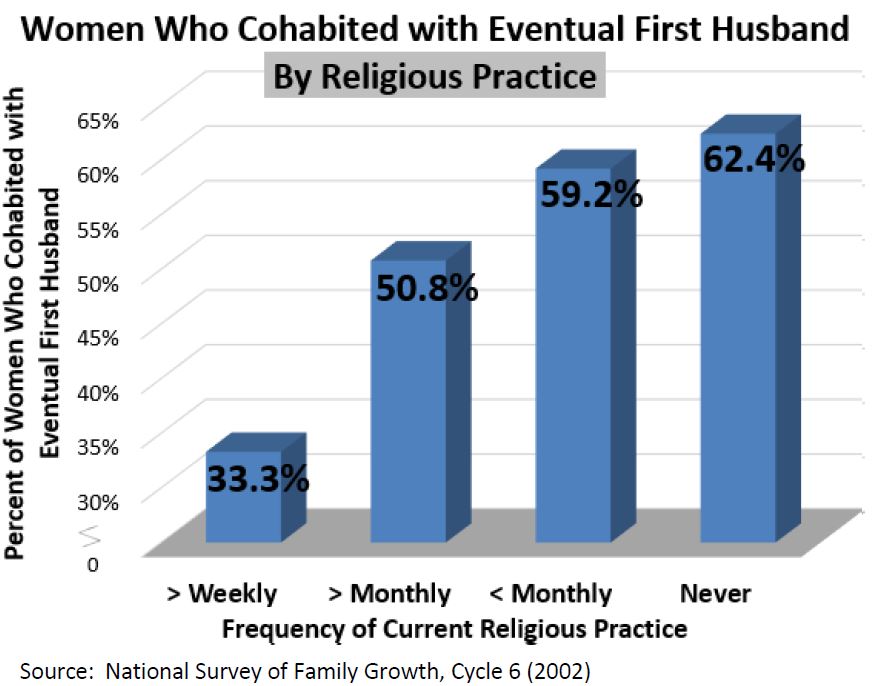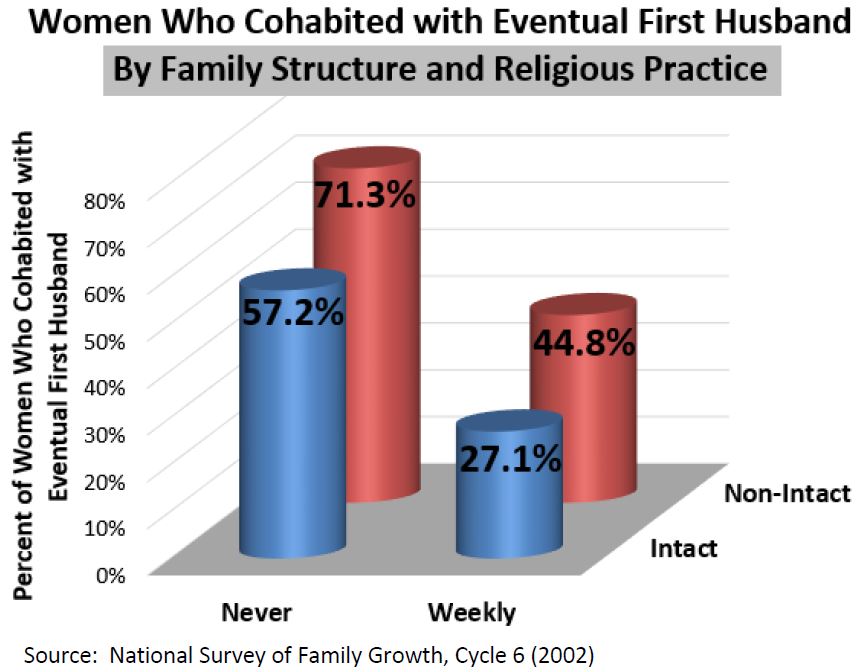Click Here to download “Women Who Cohabited with Eventual First Husband by Family Structure and Religious Practice”
Women Who Cohabited with Eventual First Husband by Family Structure and Religious Practice
Family Structure: According to the National Survey of Family Growth, Cycle 6 (2002), 42.5 percent of women who grew up in an intact married family cohabited with their eventual first husband, followed by women from single divorced parent families (55 percent), intact cohabiting families (56.2 percent), married stepfamilies (59.5 percent), always single parent families (69.4 percent), and cohabiting stepfamilies (72.9 percent).
[1]  Religious Practice:
Religious Practice: The National Survey of Family Growth shows that 33.7 percent of women who worshiped at least weekly were less likely to cohabit with their eventual first husband, followed by those who attended religious services between one and three times a month (61.6 percent), those who attended religious services less than once a month (66.8 percent), and those who never attended religious services (69.8 percent).
 Family Structure and Religious Practice Combined:
Family Structure and Religious Practice Combined: Women who were least likely to have cohabited with their eventual first husband were those who grew up in an intact married family and who worshiped at least weekly at the time of the survey. According to the National Survey of Family Growth, 27.1 percent of women who grew up in an intact married family and who worshiped at least weekly cohabited with their eventual first husband, followed by women who grew up in other family structures and worshiped at least weekly (44.8 percent), those who grew up in intact married families and never worshiped (57.2 percent), and those who grew up in other family structures and never worshiped (71.3 percent).
 Related Insights from Other Studies:
Related Insights from Other Studies: Several other studies corroborate the direction of these findings. Wendy Manning of Bowling Green State University and colleagues reported that adolescents who “have greater religiosity report lower cohabitation expectations” and that “adolescents from single, cohabiting, and married stepparent families have greater expectations to cohabit than do teens living with two biological parents.”
[2]
Jay Teachman of Western Washington University also found that those “who grew up with two biological parents…were less likely to cohabit before marriage.”
[3] Valerie Martin of McGill University and colleagues also reported that “[s]ignificantly higher levels of entry into cohabitation, as opposed to marriage, and higher levels of divorce were found among children of divorce, compared to children from intact families.”
[4] As the data show, infrequent religious attendance and a non-intact family correlate significantly with cohabitation before first marriage.
[1] These charts draw on data collected by the National Survey of Family Growth, Cycle 6 (2002). The sample consists of women between the ages of 14 and 44 and numbers 7,643.
[2] Wendy D. Manning, Monica A. Longmore, and Peggy C. Giordano, “The Changing Institution of Marriage: Adolescents’ Expectations to Cohabit and to Marry,”
Journal of Marriage and Family 69 (2007): 559-75.
[3] Jay D. Teachman, “The Childhood Living Arrangements of Children and the Characteristics of Their Marriages,”
Journal of Family Issues 25 (2004): 86-111.
[4] Valerie Martin, Melinda Mills, and Céline Le Bourdais, “The Consequences of Parental Divorce on the Life Course Outcomes of Canadian Children,”
Canadian Studies in Population 32 (2005): 29-51.]]>
 Religious Practice: The National Survey of Family Growth shows that 33.7 percent of women who worshiped at least weekly were less likely to cohabit with their eventual first husband, followed by those who attended religious services between one and three times a month (61.6 percent), those who attended religious services less than once a month (66.8 percent), and those who never attended religious services (69.8 percent).
Religious Practice: The National Survey of Family Growth shows that 33.7 percent of women who worshiped at least weekly were less likely to cohabit with their eventual first husband, followed by those who attended religious services between one and three times a month (61.6 percent), those who attended religious services less than once a month (66.8 percent), and those who never attended religious services (69.8 percent).
 Family Structure and Religious Practice Combined: Women who were least likely to have cohabited with their eventual first husband were those who grew up in an intact married family and who worshiped at least weekly at the time of the survey. According to the National Survey of Family Growth, 27.1 percent of women who grew up in an intact married family and who worshiped at least weekly cohabited with their eventual first husband, followed by women who grew up in other family structures and worshiped at least weekly (44.8 percent), those who grew up in intact married families and never worshiped (57.2 percent), and those who grew up in other family structures and never worshiped (71.3 percent).
Family Structure and Religious Practice Combined: Women who were least likely to have cohabited with their eventual first husband were those who grew up in an intact married family and who worshiped at least weekly at the time of the survey. According to the National Survey of Family Growth, 27.1 percent of women who grew up in an intact married family and who worshiped at least weekly cohabited with their eventual first husband, followed by women who grew up in other family structures and worshiped at least weekly (44.8 percent), those who grew up in intact married families and never worshiped (57.2 percent), and those who grew up in other family structures and never worshiped (71.3 percent).
 Related Insights from Other Studies: Several other studies corroborate the direction of these findings. Wendy Manning of Bowling Green State University and colleagues reported that adolescents who “have greater religiosity report lower cohabitation expectations” and that “adolescents from single, cohabiting, and married stepparent families have greater expectations to cohabit than do teens living with two biological parents.”[2]
Jay Teachman of Western Washington University also found that those “who grew up with two biological parents…were less likely to cohabit before marriage.”[3] Valerie Martin of McGill University and colleagues also reported that “[s]ignificantly higher levels of entry into cohabitation, as opposed to marriage, and higher levels of divorce were found among children of divorce, compared to children from intact families.”[4] As the data show, infrequent religious attendance and a non-intact family correlate significantly with cohabitation before first marriage.
[1] These charts draw on data collected by the National Survey of Family Growth, Cycle 6 (2002). The sample consists of women between the ages of 14 and 44 and numbers 7,643.
[2] Wendy D. Manning, Monica A. Longmore, and Peggy C. Giordano, “The Changing Institution of Marriage: Adolescents’ Expectations to Cohabit and to Marry,” Journal of Marriage and Family 69 (2007): 559-75.
[3] Jay D. Teachman, “The Childhood Living Arrangements of Children and the Characteristics of Their Marriages,” Journal of Family Issues 25 (2004): 86-111.
[4] Valerie Martin, Melinda Mills, and Céline Le Bourdais, “The Consequences of Parental Divorce on the Life Course Outcomes of Canadian Children,” Canadian Studies in Population 32 (2005): 29-51.]]>
Related Insights from Other Studies: Several other studies corroborate the direction of these findings. Wendy Manning of Bowling Green State University and colleagues reported that adolescents who “have greater religiosity report lower cohabitation expectations” and that “adolescents from single, cohabiting, and married stepparent families have greater expectations to cohabit than do teens living with two biological parents.”[2]
Jay Teachman of Western Washington University also found that those “who grew up with two biological parents…were less likely to cohabit before marriage.”[3] Valerie Martin of McGill University and colleagues also reported that “[s]ignificantly higher levels of entry into cohabitation, as opposed to marriage, and higher levels of divorce were found among children of divorce, compared to children from intact families.”[4] As the data show, infrequent religious attendance and a non-intact family correlate significantly with cohabitation before first marriage.
[1] These charts draw on data collected by the National Survey of Family Growth, Cycle 6 (2002). The sample consists of women between the ages of 14 and 44 and numbers 7,643.
[2] Wendy D. Manning, Monica A. Longmore, and Peggy C. Giordano, “The Changing Institution of Marriage: Adolescents’ Expectations to Cohabit and to Marry,” Journal of Marriage and Family 69 (2007): 559-75.
[3] Jay D. Teachman, “The Childhood Living Arrangements of Children and the Characteristics of Their Marriages,” Journal of Family Issues 25 (2004): 86-111.
[4] Valerie Martin, Melinda Mills, and Céline Le Bourdais, “The Consequences of Parental Divorce on the Life Course Outcomes of Canadian Children,” Canadian Studies in Population 32 (2005): 29-51.]]>
